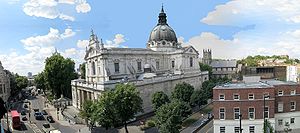
London Oratory
Encyclopedia

Roman Catholic Church
The Catholic Church, also known as the Roman Catholic Church, is the world's largest Christian church, with over a billion members. Led by the Pope, it defines its mission as spreading the gospel of Jesus Christ, administering the sacraments and exercising charity...
oratory
Oratory of Saint Philip Neri
The Oratory of Saint Philip Neri is a congregation of Catholic priests and lay-brothers who live together in a community bound together by no formal vows but only with the bond of charity. They are commonly referred to as Oratorians...
, a community of lay-brothers, and the name given to the London Congregation of the Oratory of Saint Philip Neri
Oratory of Saint Philip Neri
The Oratory of Saint Philip Neri is a congregation of Catholic priests and lay-brothers who live together in a community bound together by no formal vows but only with the bond of charity. They are commonly referred to as Oratorians...
. It is housed in an Oratory House, next to the Church of the Immaculate Heart of Mary
Church of the Immaculate Heart of Mary
The Church of the Immaculate Heart of Mary, popularly known as Brompton Oratory, is a Roman Catholic church in South Kensington, London...
in the Brompton Road
Brompton Road
Brompton Road is a street in Knightsbridge, London, in The Royal Borough of Kensington and Chelsea .It starts from Knightsbridge tube station and runs south-west through an extremely wealthy residential area until it reaches Egerton Gardens and the area to the east of South Kensington tube station...
, Royal Borough of Kensington and Chelsea, London, SW7.
There are two other Oratories in the UK
United Kingdom
The United Kingdom of Great Britain and Northern IrelandIn the United Kingdom and Dependencies, other languages have been officially recognised as legitimate autochthonous languages under the European Charter for Regional or Minority Languages...
, the Birmingham Oratory
Birmingham Oratory
The Birmingham Oratory is a Catholic oratory and church, on the Hagley Road, in the Birmingham suburb of Edgbaston in England.-History:The church was constructed between 1907 and 1910 in the Baroque style as a memorial to Cardinal Newman, founder of the English Oratory...
and the Oxford Oratory
Oxford Oratory
The Oxford Oratory Church of St Aloysius Gonzaga is the Catholic parish church for the centre of Oxford, England. It is located at 25 Woodstock Road. The church is presently served by the Congregation of the Oratory....
.
Origins
The London Oratory was founded in 1849, the year after John Henry Cardinal Newman established the Birmingham OratoryBirmingham Oratory
The Birmingham Oratory is a Catholic oratory and church, on the Hagley Road, in the Birmingham suburb of Edgbaston in England.-History:The church was constructed between 1907 and 1910 in the Baroque style as a memorial to Cardinal Newman, founder of the English Oratory...
, when Newman sent Frederick Faber and some companions, including Thomas Francis Knox
Thomas Francis Knox
Father Francis Knox Father Francis Knox Father Francis Knox (born as Thomas Francis Knox; 24 December 1822 — 20 March 1882, LondonKnox, whose profile in the claims he was born in County Armagh, not Brussels, was an Anglo-Irish ultramontane Roman Catholic priest and author, known for his historical...
, to start an Oratory in London. The original premises
Folly Theatre
The Folly Theatre was a London theatre of the late 19th century, in William IV Street, near Charing Cross, in the City of Westminster. It was converted from the house of a religious order, and became a small theatre, with a capacity of 900 seated and standing. The theatre specialised in presenting...
(a former whisky store) were in King William Street (now William IV Street), near Charing Cross
Charing Cross
Charing Cross denotes the junction of Strand, Whitehall and Cockspur Street, just south of Trafalgar Square in central London, England. It is named after the now demolished Eleanor cross that stood there, in what was once the hamlet of Charing. The site of the cross is now occupied by an equestrian...
. In 1854 the community moved to its present Brompton Road site, adjacent to the Victoria and Albert Museum
Victoria and Albert Museum
The Victoria and Albert Museum , set in the Brompton district of The Royal Borough of Kensington and Chelsea, London, England, is the world's largest museum of decorative arts and design, housing a permanent collection of over 4.5 million objects...
. An Oratory House was built in 1854, followed by a large temporary church. The church was replaced in 1884 by the present neo-baroque
Neo-baroque
The Baroque Revival or Neo-baroque was an architectural style of the late 19th century. The term is used to describe architecture which displays important aspects of Baroque style, but is not of the Baroque period proper—i.e., the 17th and 18th centuries.Some examples of Neo-baroque architecture:*...
building, designed by Herbert Gribble. Until the opening of Westminster Cathedral in 1903, the London Oratory was the venue for all great Catholic occasions in London, including the funeral of Cardinal Manning in 1892.
Together with their Church of the Immaculate Heart of Mary
Church of the Immaculate Heart of Mary
The Church of the Immaculate Heart of Mary, popularly known as Brompton Oratory, is a Roman Catholic church in South Kensington, London...
, the community of the Oratorian Fathers is often popularly, though incorrectly, referred to as the 'Brompton Oratory'.

